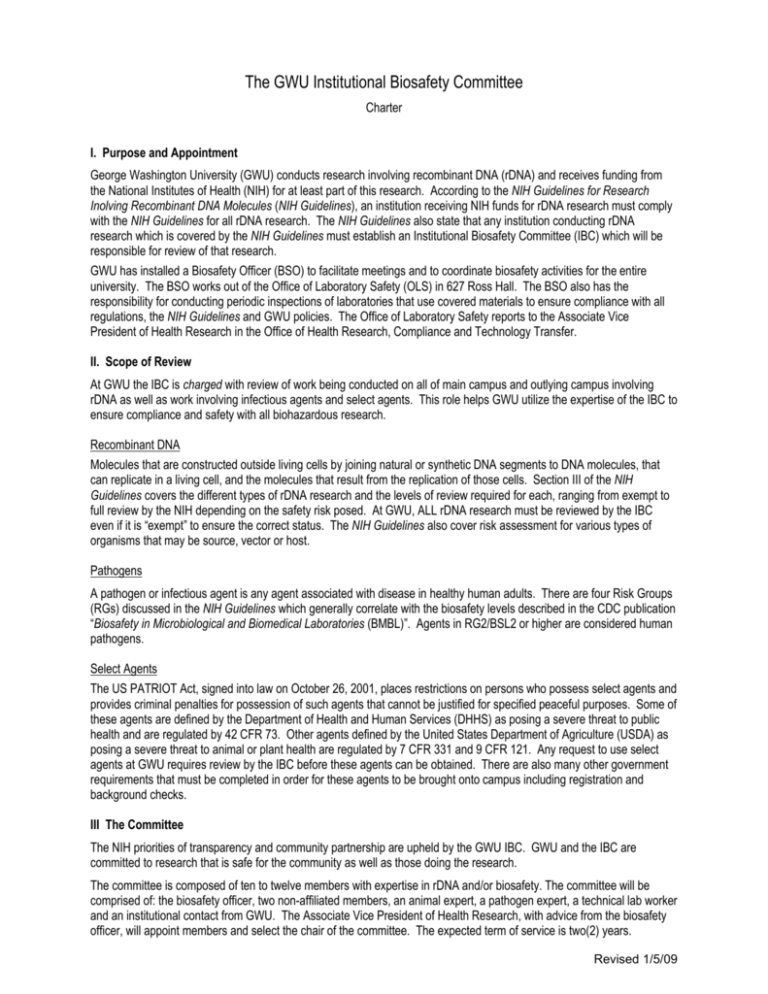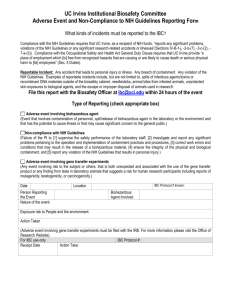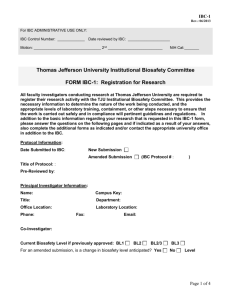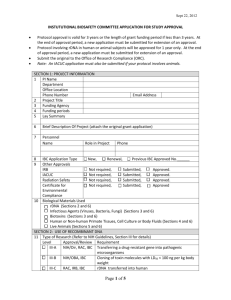Institutional Biosafety Committee
advertisement

The GWU Institutional Biosafety Committee Charter I. Purpose and Appointment George Washington University (GWU) conducts research involving recombinant DNA (rDNA) and receives funding from the National Institutes of Health (NIH) for at least part of this research. According to the NIH Guidelines for Research Inolving Recombinant DNA Molecules (NIH Guidelines), an institution receiving NIH funds for rDNA research must comply with the NIH Guidelines for all rDNA research. The NIH Guidelines also state that any institution conducting rDNA research which is covered by the NIH Guidelines must establish an Institutional Biosafety Committee (IBC) which will be responsible for review of that research. GWU has installed a Biosafety Officer (BSO) to facilitate meetings and to coordinate biosafety activities for the entire university. The BSO works out of the Office of Laboratory Safety (OLS) in 627 Ross Hall. The BSO also has the responsibility for conducting periodic inspections of laboratories that use covered materials to ensure compliance with all regulations, the NIH Guidelines and GWU policies. The Office of Laboratory Safety reports to the Associate Vice President of Health Research in the Office of Health Research, Compliance and Technology Transfer. II. Scope of Review At GWU the IBC is charged with review of work being conducted on all of main campus and outlying campus involving rDNA as well as work involving infectious agents and select agents. This role helps GWU utilize the expertise of the IBC to ensure compliance and safety with all biohazardous research. Recombinant DNA Molecules that are constructed outside living cells by joining natural or synthetic DNA segments to DNA molecules, that can replicate in a living cell, and the molecules that result from the replication of those cells. Section III of the NIH Guidelines covers the different types of rDNA research and the levels of review required for each, ranging from exempt to full review by the NIH depending on the safety risk posed. At GWU, ALL rDNA research must be reviewed by the IBC even if it is “exempt” to ensure the correct status. The NIH Guidelines also cover risk assessment for various types of organisms that may be source, vector or host. Pathogens A pathogen or infectious agent is any agent associated with disease in healthy human adults. There are four Risk Groups (RGs) discussed in the NIH Guidelines which generally correlate with the biosafety levels described in the CDC publication “Biosafety in Microbiological and Biomedical Laboratories (BMBL)”. Agents in RG2/BSL2 or higher are considered human pathogens. Select Agents The US PATRIOT Act, signed into law on October 26, 2001, places restrictions on persons who possess select agents and provides criminal penalties for possession of such agents that cannot be justified for specified peaceful purposes. Some of these agents are defined by the Department of Health and Human Services (DHHS) as posing a severe threat to public health and are regulated by 42 CFR 73. Other agents defined by the United States Department of Agriculture (USDA) as posing a severe threat to animal or plant health are regulated by 7 CFR 331 and 9 CFR 121. Any request to use select agents at GWU requires review by the IBC before these agents can be obtained. There are also many other government requirements that must be completed in order for these agents to be brought onto campus including registration and background checks. III The Committee The NIH priorities of transparency and community partnership are upheld by the GWU IBC. GWU and the IBC are committed to research that is safe for the community as well as those doing the research. The committee is composed of ten to twelve members with expertise in rDNA and/or biosafety. The committee will be comprised of: the biosafety officer, two non-affiliated members, an animal expert, a pathogen expert, a technical lab worker and an institutional contact from GWU. The Associate Vice President of Health Research, with advice from the biosafety officer, will appoint members and select the chair of the committee. The expected term of service is two(2) years. Revised 1/5/09 Meetings will generally be held monthly but may be more or less frequent depending on business needs. For a meeting to proceed there must be at least 5 members in attendance including at least one non-affiliated member (or someone from the community to stand in). The meeting must be conducted by the chair or the biosafety officer. If the type of work being reviewed requires the advice of a particular expert then this person must be present or in rare instances, if they are unable to come in person, they may participate by teleconference. All members will have appropriate training to be able to effectively review projects. This training will be conducted by the biosafety officer on an annual basis. If research submitted by the chair is approved, then it must be signed by a senior faculty member of the committee Anyone interested in attending an IBC meeting should contact the OLS at 202-994-2630 or visit the OLS website for details on the next meeting. OLS will accommodate requests when possible in accordance with privacy and proprietary concerns. Meeting minutes will be taken at each meeting and filed in the OLS office. Meeting minutes, or other documents that must be made available to the public, may be obtained by placing a request with OLS and allowing at least two weeks for processing and, if necessary, redaction of documents. Requests of 15 pages or less are free. Requests of more than 15 pages will require a fee of $10 plus 10 cents per page to cover processing and materials. The requestor will also be responsible for shipping costs. Information that may be redacted includes but is not limited to: proprietary information such as trade secrets or other intellectual property, personal information such as home phone numbers or addresses, or information that could compromise institutional or national security. IV. Responsibilities The IBC responsibilities are derived from the NIH Guidelines: Review research that involves recombinant DNA, pathogens or select agents including a full risk assessment, selection of proper containment and assign any special provisions. The IBC may lower or raise containment within what is allowed by the NIH Guidelines based on the risk assessment. Notify PIs of the results of the review. Periodically review approved research. Adopt emergency plans for spill or exposure Ensure that GWU biosafety policy is in compliance with the NIH Guidelines for rDNA Report any significant problems with or violations of the NIH Guidelines or any significant accidents or illnesses to the institutional official and the OBA according to the requirements of the NIH Guidelines. Significant violations or incidents may include items such as: o Breach of containment for rDNA such as escaped animals or microorganisms, or a spill, outside of containment (ie: BSC) that cannot be easily and quickly cleaned up by one person. Any spill in a BSL3 facility, which is outside of containment, should be reported. o Any worker exposure of rDNA to mucus membranes or open skin or inhalation of aerosols and any potential exposure at BSL3. o Any illness likely caused by rDNA exposure o Workers or PIs that willfully violate protocols or conduct work without prior IBC approval. Note: PIs, workers, and other staff must report any of the above items to the Biosafety Officer. V. The Review Process: Anyone working with agents covered in the scope of review by the IBC must have their research reviewed by the IBC whether the research is funded by NIH or not. This document applies to all research areas on campus or outlying campuses, as well as the Medical Faculty Association (MFA). To initiate a review by the committee you must submit: the IBC registration form the research description form Standard Operating Procedure (SOP) for any process that involves a pathogen IACUC form A safety sheet – for work involving whole, live vertebrate animals Note: the IBC form may require other documents to be submitted, depending on other hazards that may be involved in the work or as deemed necessary. The documents must be sent to OLS via email. The submission email should be come from the primary PI. It is fine for someone else associated with the lab to submit the forms for the primary PI, however, the primary PI must be copied on the email. A primary PI is the PI who is ultimately responsible for the lab space and thus ultimately responsible for safety. Revised 1/5/09 If another person working for the primary PI prepares the submission, they must copy the primary PI on the email. Proposals must be received at least 2 weeks prior to a meeting to be on the agenda for that meeting. Meeting dates are available on the OLS website at the IBC registration page: http://www.gwumc.edu/research/biosafety_bc.htm Each proposal to be reviewed will be sent in advance to all committee members for preliminary review and generally one member will be asked to summarize the proposal at the meeting. The committee will review the material at a regularly scheduled meeting and, after making sure it is within the scope of the committee function, will conduct a risk assessment based on the documents submitted. The committee will determine the proper containment and any other procedures that are deemed necessary for safety. The PI for the lab or representatives sent by the PI may be invited to the meeting to answer questions by the committee but may not be present during discussion. There may be times when the attendance by the PI or their representatives is mandatory. If anyone on the committee, due to a conflict of interest may not be able to provide an unbiased opinion, they must be excused from the discussion of that particular proposal. If someone must be excused from discussion on a protocol, the minimum attendance and expertise must still be maintained using members, visitors or ad hoc consultants. The committee will then decide whether to approve the research. Approval requires a two thirds vote but every effort should be made to gain unanimous approval. If more information is needed or if there are serious problems with the proposal, the committee will notify the applicant as to what is needed and take it up again at the next scheduled meeting. If there are only some small changes needed, the committee may approve the proposal contingent on these items being corrected. When the items are corrected, only signatures from the Biosafety Officer and the committee chair are required for full approval. If approved, a letter of approval will be sent to the submitter and all information regarding the approval will be added to the OLS database. Approvals are effective for 5 years. Protocols may be re-approved only by full committee review when they expire or at the discretion of the committee. The IBC may revoke an approval if it is determined that the research is not in compliance with NIH Guidelines or the GWU biosafety manual. To renew a protocol, a complete IBC form must be submitted along with supporting documents; similar to a new submission. Periodic Reviews Each approved project will be reviewed annually. OLS will contact the PI to inquire if there are any changes to the research. The PI must update the IBC form to reflect any changes and send it to OLS. The biosafety officer will review any changes to determine if there is anything significant enough to require an amendment. This initial review will check not only for changes to the protocol but also changes in regulations, law or university policy that may necessitate changes to the protocol. Amendments If significant changes are made during the course of ongoing approved research, then the proposal must be amended. The PI should make the amendment when the change occurs and not wait until the annual review. A substantial change would include: a change in research class or biosafety level; a new select agent; a new pathogen; a major modification of a unique, non-commercial expression vector; any change in an expression vector resulting in increased levels of transgene expression; large changes in the nature of an inserted gene (i.e.: oncogene, virulence, origin or replication). The committee will review the amendment and investigators will be notified by email of the committee’s decision and any action needed. To submit: open the original electronic copy of the registration form, turn on “track changes", make the changes and send it to OLS via email. The following items should be In the email: 1. Write a brief synopsis outlining the original work approved by the committee. 2. Explain the changes describing the nature of the insert, modification of the vector or changes in the host. Human Gene Transfer If research involving human gene transfer is submitted, the committee will ensure that: no participant will be enrolled before all requirements of the NIH Guidelines (including appendix M) are completed including: The detailed protocol and consent form are submitted to the IBC for the review and these documents clearly indicate how to report incidents that may arise The committee has adequate expertise and training to review the project (using ad hoc consultants as needed). All necessary external reviews and/or approvals have been obtained whether from the NIH/RAC, FDA or others. Revised 1/5/09 The research has been approved by the GWU IBC and IRB. VI. Inspections Laboratory facilities and other areas where research is conducted will be inspected annually by OLS to ensure that work is being done at the proper containment and in compliance with the GWU biosafety manual. Inspections may be unannounced and may be more frequent depending on risk or if violations have been found previously. Commitment to a quality process The Institutional Biosafety Committee and the Office of Laboratory Safety have made great efforts to streamline the process and reduce paperwork while adhering to the NIH guidelines and the principles of sound biosafety. Please contact the OLS with any feedback about the process. Revised 1/5/09







